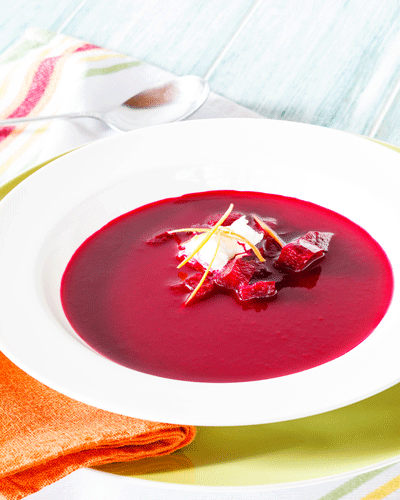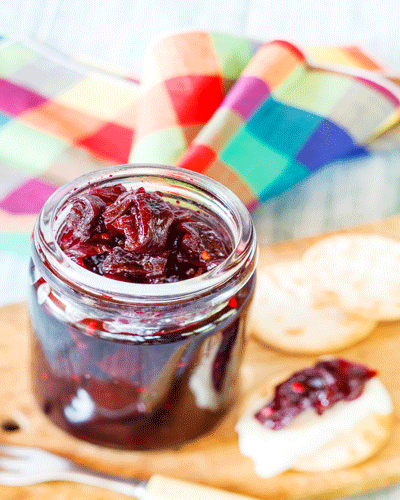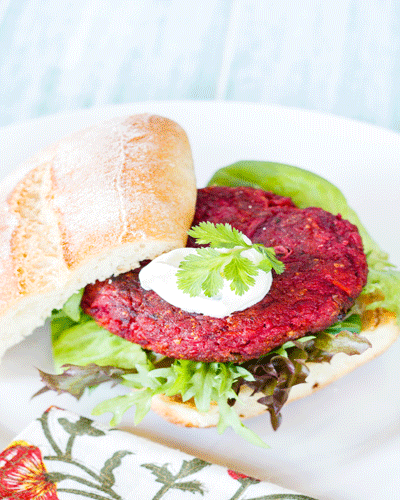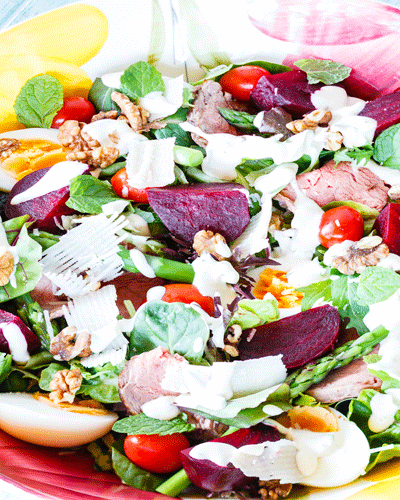
Brazen Beetroots
A hamburger with the lot or salad sandwich just wouldn’t be the same without it. An Aussie staple, the humble beetroot brightens up a variety of dishes with its vibrant colouring. Beetroots come in all shapes and sizes but the most common is round, and vivid red in colour. Other varieties are white, yellow, and even candy-striped.
Beetroot is thought to have evolved from wild Sea beet native to the coastlines from India to Britain. Sea beet was first cultivated in the eastern Mediterranean and Middle East, although only the leaves were eaten at the time. The round root of the modern beetroot was not developed until the sixteenth century and became widely popular in Central and Eastern Europe 200 years later. Many classic beetroot dishes originated in this area including the famous Ukrainian beetroot soup; borscht.
Selection, storage and preparation: Related to the silver beet, turnip, and swede, beetroots are grown all year round in Australia. The smallest variety, the baby beet, has become a popular choice as it takes up a small amount of room and can easily be grown in a pot. Other varieties include the Super King, Detroit Red, Cylindra and the Derwent Globe. As a rule of thumb, the smaller they are the sweeter the crop. Look for smooth-skinned beetroot, with no splits or blemishes and their leaves and stems still intact.
You can store beetroot in a plastic bag in the fridge for up to 2 weeks however their leaves should only be stored in the fridge for 2 to 3 days.
There are endless beetroot recipes to choose from. The ever versatile beetroot can be grated raw, pureed, boiled, baked, pickled, or used in soups. They have a juicy and slightly sweet flavour that complements many savoury dishes, as well as the occasional sweet one. Supercharge your chocolate cake recipe with some mashed beetroot next time. The combination of sweet earthy beetroot with chocolate is surprisingly delectable. Don’t forget the leaves; they can be blanched and used in soups, salads, pasta sauces, or stuffing.
Beetroots go with: soups, salads, dips, burgers, walnuts, pine nuts, goat’s cheese, brie, sour cream, prosciutto, pancetta, bacon, steak, duck, quail, chicken, smoked salmon, barramundi, garlic, celery, carrot, onion, dill, mint, sage, parsley, fennel, apple, orange, vinegar, and chocolate.
Chilled Beetroot & Orange Soup
Serves 4
- 500g fresh beetroot, washed and stems trimmed
- 2 teaspoons finely chopped ginger
- 1 small onion, finely chopped
- 2 cups chicken or vegetable stock
- 2 cups fresh orange juice
- 2 tablespoons Balsamic vinegar
- Grated carrot, to garnish- optional
- Crème fraiche, to serve
Place beetroot in a saucepan, cover with water and bring to the boil. Reduce heat and simmer for 20-30 minutes or until tender. Drain; reserve 2 cups of strained beetroot liquid. When cool enough to handle, peel beetroot and cut into small cubes. Reserve 1/2 cup chopped beetroot (for serving). Combine remaining beetroot, ginger, onion, stock and reserved beetroot liquid in a saucepan bring to the boil. Reduce heat and simmer for 10 minutes. Remove from heat and stir in the orange juice. Puree the soup in batches, using a food processor until smooth. Transfer soup to a bowl, cool to room temperature. Cover and refrigerate until chilled. To serve, stir in vinegar and season to taste. Ladle soup into serving bowls and add a spoonful of reserved beetroot to each bowl. Serve topped with crème fraiche and grated carrot.
Chilli Beetroot Chutney
Makes approximately 3 cups
- 1kg beetroot, washed and stems trimmed
- 1 teaspoon salt
- 11/2 cups sugar
- 150ml red wine vinegar
- 2 teaspoons dried crushed chillies
- 4 whole black peppercorns
Place beetroot in a saucepan, cover with water, add salt and bring to the boil. Reduce heat and simmer for 15-20 minutes or until the beetroot starts to become tender. Remove from heat and cool the beetroot in the liquid. When the beetroot has cooled enough to handle, remove with a slotted spoon and strain the cooking liquid and reserve. Peel beetroot and cut into small chunks. Combine sugar, vinegar, dried chilli, peppercorns and 150ml of reserved cooking liquid in a saucepan and stir over low heat until the sugar dissolves. Add the beetroot and bring to the boil. Simmer for 40-45 minutes, stirring frequently. The chutney is ready when it reaches 105C on a sugar thermometer or until it coats the back of a wooden spoon. The consistency of the chutney should be sticky and similar to jam. Spoon the chutney into warm, sterilised jars. Seal while hot, then cool and refrigerate until required. Serve at room temperature.
This chutney is delicious served with cheese or as an accompaniment to game and red meats.
Beetroot Patties with Lemon and Coriander Crème Fraiche
Makes 12 large patties
- 2 packet’s instant noodles, cooked and drained
- 400g fresh beetroot, scrubbed and coarsely grated
- 1 medium carrot, scrubbed and coarsely grated
- 1 medium parsnip, scrubbed and coarsely grated
- 80g haloumi cheese, drained and coarsely grated
- 3 shallots, finely chopped
- 2 tablespoons finely chopped, coriander leaves
- 1 teaspoon cumin
- 1 cup breadcrumbs
- Salt and pepper, to taste
- 2 eggs, lightly beaten
- Olive oil for frying
Dressing ingredients
- 200g Crème fraiche
- 2 tablespoons extra virgin olive oil
- 2 tablespoon fresh lemon juice or to taste
- 1 teaspoon Dijon mustard
- 2 tablespoons finely chopped, fresh coriander leaves
- Salt and pepper, to taste
Using gloves, squeeze out excess liquid from grated vegetables. Place all the ingredients in a large bowl, mix well to combine. Cover with cling wrap and refrigerate 30 minutes. Form mixture into 12 round patties. Heat the oil in a large frying pan and fry the patties in batches for 2-3 minutes each side, flattening with a spatula, until golden and heated through. Drain on paper towel and then place on a plate to keep warm in a low oven while cooking the rest. To make the dressing, combine all the ingredients in a screw-top jar and shake until blended. Serve as burgers or with a green salad and crusty bread.
Beef and Beetroot Salad with Horseradish Yogurt Dressing
Serves 4-6
- 2 tablespoons olive oil
- 700g beef fillet (or lamb), trimmed
- Freshly ground black pepper
- 4 medium beetroot, washed and stems trimmed
- 1 teaspoon salt
- 1 bunch asparagus, washed and tough ends removed
- 100g mixed baby salad leaves, washed
- 1/2 punnet cherry tomatoes, washed and halved or left whole
- 4 boiled eggs, halved or quartered
- 50g walnuts, roasted
- 1 good handful of fresh mint leaves
- 1 cup shaved parmesan cheese
- Dressing ingredients
- 200g natural yogurt
- 2 tablespoons horseradish cream
- 2 tablespoons freshly squeezed lemon juice
- 2 tablespoons fresh mint, finely chopped
- Salt and freshly ground black pepper, to taste
Place the beetroot in a saucepan, cover with water, add salt and bring to the boil. Reduce heat and simmer 20-30 minutes or until tender. Drain. When cool enough to handle, peel beetroot and cut into halves or quarters, depending on their size. Meanwhile, season fillet with ground pepper. Heat the oil and sear in a heavy based frying pan over high heat until well browned on all sides. Transfer to a wire rack in a roasting pan and cook at 180C for 40 minutes, or less if you prefer rare. Remove from oven and rest, loosely covered with foil for at least 15 minutes. Blanch asparagus in boiling salted water for 2 minutes. Remove the asparagus with a slotted spoon and refresh in iced water to stop the cooking process. Slice the cooled asparagus in halves, or leave whole. Place salad leaves into a serving dish or platter and layer with sliced beef, beetroot, asparagus, tomatoes, boiled eggs, walnuts, a sprinkle of mint leaves and parmesan. Dribble over the dressing and toss through when serving or serve the dressing on the side. To make the dressing, combine all of the ingredients in a screw-top jar and shake until blended.
Note: You may use more or less of the salad ingredients as you wish. It’s a wonderful dish when thrown together, looks and tastes great.













